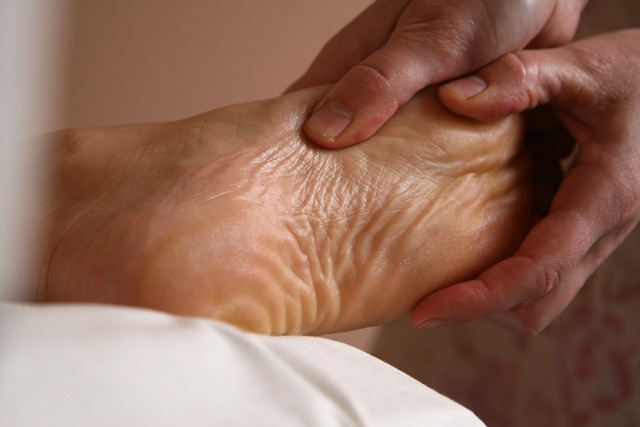The RICE method (Rest, Ice, Compression, Elevation) is a widely recommended initial treatment for acute sports injuries, aiming to reduce swelling and inflammation while providing immediate pain relief. Ice therapy constricts blood vessels, numbs pain, and controls fluid leakage; compression manages swelling through gentle pressure; and elevation facilitates the drainage of excess fluid from the injury site. Correct application involves applying ice for 15-20 minutes every few hours, up to 48-72 hours post-injury, while elevating the affected area above heart level and monitoring skin temperature to prevent frostbite.
“Acute injuries often come with swelling and inflammation, leading to pain and hindered recovery. Understanding these initial responses is crucial in managing such conditions effectively. This article explores the RICE method—a popular strategy for reducing swelling and inflammation in acute injuries, particularly among athletes. We’ll delve into the science behind it, provide a step-by-step guide to ice therapy, and discuss its benefits and precautions, offering valuable insights for sports professionals.”
Understanding Swelling and Inflammation in Acute Injuries
Swelling and inflammation are common responses to acute injuries, such as sprains, strains, and contusions. They play a crucial role in the body’s natural healing process by helping to isolate and protect damaged tissues from further harm. However, excessive swelling can lead to increased pain, stiffness, and decreased function. This is where the RICE method—Rest, Ice, Compression, and Elevation—proves invaluable as a quick and effective strategy for managing these symptoms in sports injuries.
Understanding the mechanisms behind swelling and inflammation allows athletes and healthcare professionals to employ the RICE method appropriately. Resting the affected area helps prevent further damage by reducing the impact on injured tissues. Applying ice is particularly effective in reducing inflammation, constricting blood vessels to decrease fluid leakage into surrounding tissues, thus minimizing swelling. Compression aids in controlling edema by applying gentle pressure, while elevation helps drain excess fluid from the injury site.
Introduction to the RICE Method
The RICE method, short for Rest, Ice, Compression, and Elevation, is a fundamental approach to managing acute injuries, especially in the context of sports. It’s a simple yet powerful tool that provides immediate relief and supports the healing process. The RICE method for sports injuries is widely recommended by medical professionals as an initial treatment protocol.
By applying these four steps, athletes and individuals with sports-related injuries can effectively reduce swelling and inflammation. Resting the affected area prevents further damage and allows the body to direct its resources towards healing. Ice therapy, a key component, constricts blood vessels to minimize fluid leakage and reduces pain by numbing the injured site. Compression helps to control swelling by applying gentle pressure, while elevation ensures that any excess fluid drains away from the injury site.
Step-by-Step Guide to Applying Ice Therapy
Applying ice therapy, often recommended as part of the RICE (Rest, Ice, Compression, Elevation) method for sports injuries, is a simple yet effective way to reduce swelling and inflammation in acute injuries. Here’s a step-by-step guide:
1. Protect Your Skin: Wrap an ice pack or several bags of frozen vegetables in a thin towel to prevent direct contact with skin, which can cause frostbite.
2. Apply Ice: Position the ice pack on the affected area for 15-20 minutes. It’s best to apply it immediately after the injury occurs and repeat every few hours for the first 48-72 hours.
3. Elevate the Affected Area: If possible, elevate the injured part of your body above the level of your heart. This helps reduce swelling by minimizing blood flow to the area.
4. Monitor and Adjust: Check the skin regularly while applying ice to ensure it’s not too cold. If it becomes red or feels numb, remove the ice pack briefly and reapply after the skin has warmed slightly.
Benefits and Precautions of Using Ice for Injury Recovery
The RICE method—Rest, Ice, Compression, Elevation—is a widely recommended strategy for managing acute injuries, particularly in sports medicine. Ice, specifically, plays a crucial role in reducing swelling and inflammation, two key factors that contribute to pain and hindered recovery. When applied correctly, ice can numb the affected area, decreasing nerve impulses and alleviating discomfort. Additionally, it constricts blood vessels, limiting the flow of fluid into the injured tissues, which helps to minimize swelling.
However, while ice has numerous benefits for injury recovery, it should be used with caution. Prolonged or direct application of ice can lead to tissue damage due to frostbite or cryo-injury. Individuals with poor circulation or nerve damage should exercise extra care, as they may be more susceptible to these risks. It’s essential to follow the RICE method guidelines: apply ice for 15–20 minutes every few hours, but ensure the skin is never in direct contact with the ice pack to prevent cold-related injuries.
The RICE method, a cornerstone in managing acute injuries, particularly in sports, effectively reduces swelling and inflammation. By understanding these physiological responses and employing ice therapy as outlined in this guide, athletes and active individuals can expedite their recovery process. Remember, the RICE protocol is just one aspect of injury care; seeking professional medical advice for severe or persistent conditions is essential. Embrace the benefits of ice while being mindful of precautions to ensure a safe and speedy return to activity.
